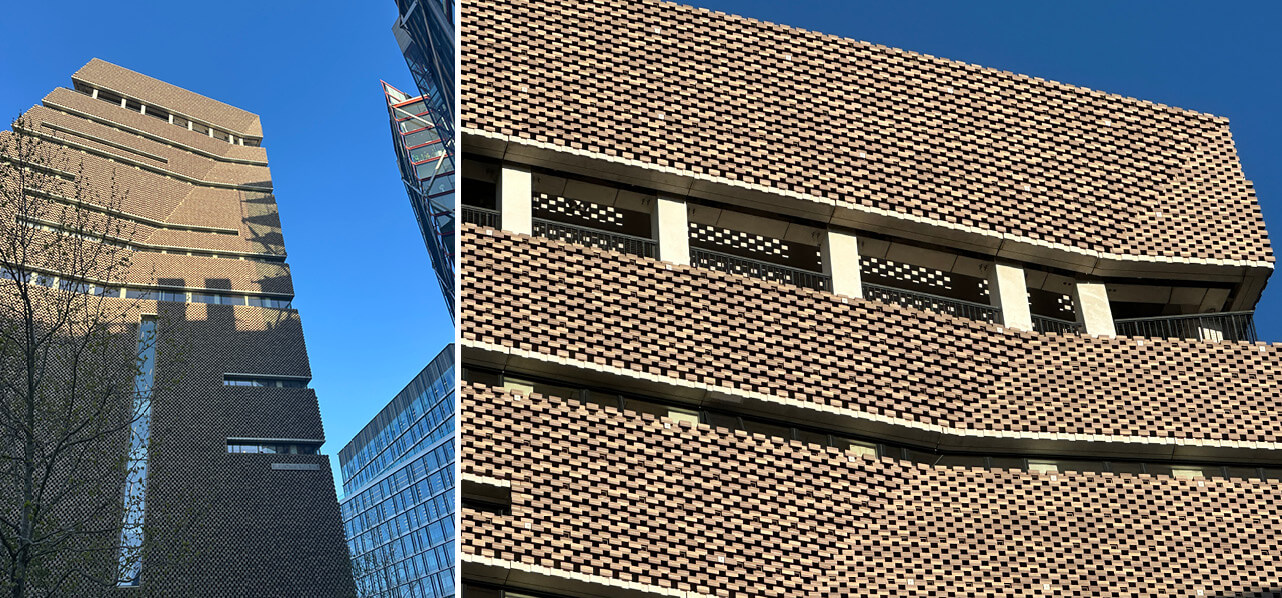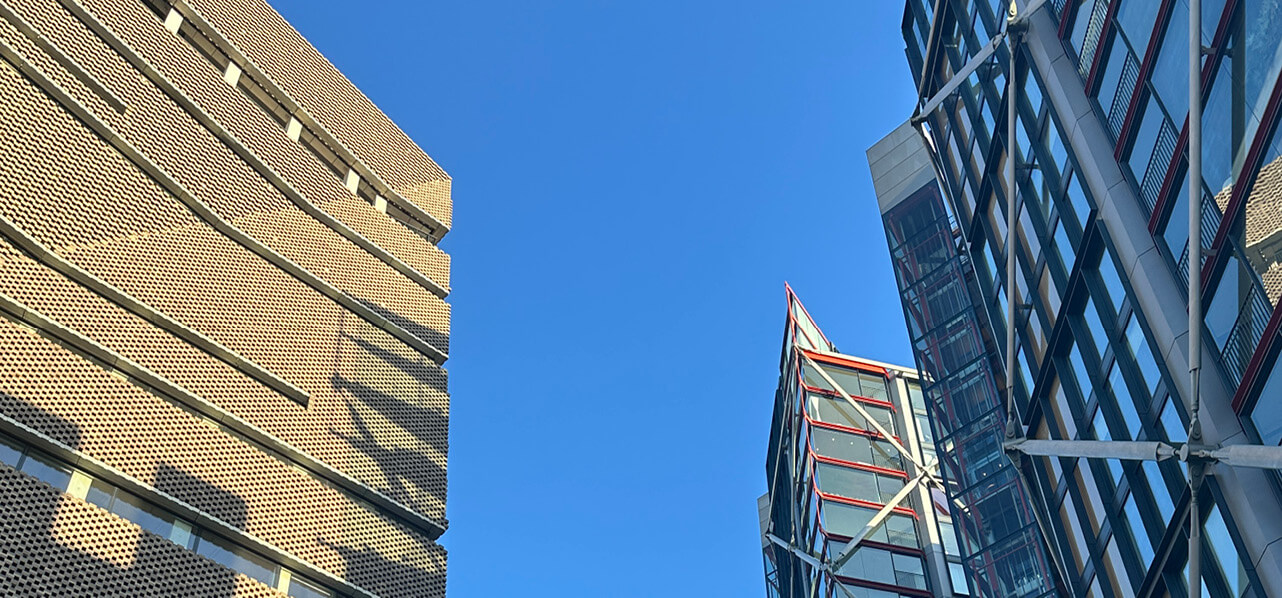Partner London
"Intense constant visual intrusion was a legal nuisance."
Bird’s Eye View
First, let us explain the judgment on its face.
In June 2016, the Tate Modern, a leading art gallery in London, opened the top storey of its newly constructed Blavatnik Building as a viewing gallery. It was open on all sides and so offered windowless views in every direction. Here are photographs of the building and the viewing gallery.
On the southside, these views included the Neo Bankside apartment block (pictured below), located 34 metres away. As that building had recently been built with curtain walls (i.e. walls comprising mostly glass), the interiors of the residences on its 13th to the 21st floors could be readily seen from the viewing gallery. Indeed, residents sometimes found photographs of their dining and living rooms posted on social media by visitors to the Tate Modern.
What a nuisance
Some of the Neo Bankside residents claimed that this intrusion was a legal nuisance. ‘Nuisance’ is the wrongful interference with the ordinary use and enjoyment of one’s land. What amounts to ordinary use is determined by having regard to the character of the locality of where the land is situated. For something to amount to a nuisance the interference must be substantial, determined objectively by the standards of an ordinary person.
The Supreme Court ultimately agreed with the residents. This garnered both press and public attention as a colourful illustration of how the categories of nuisance could be expanded beyond typical intangible examples such as noise, fumes and vibrations. This was not a case of “mere overlooking” (which could not give rise to liability in nuisance) but intense constant visual intrusion which was a legal nuisance.
"The reciprocity rule of 'give and take'."
The View of the Majority
In the leading judgment of Lord Leggatt, the Court explained the reasons for its decision which can be summarised as follows:
- the correct legal test was whether operating a viewing platform was necessary for the common and ordinary use and occupation of an art gallery, rather than whether it was unreasonable to operate a viewing platform as part of the Tate Modern’s use of their land;
- “ordinary use” is assessed by having regard to the character of the location. Although the Tate Modern is an art gallery situated in an urban area of central London, inviting members of public up to a viewing platform was not “ordinary use”. It was a very particular and exceptional use of land in that locality;
- the apartment owners chose to live in homes made with glass walls and had, therefore, exposed themselves to visual intrusion from ordinary sources. However, this was no defence for the Tate Modern because it had not been using its land in an “ordinary” way. A comparison was even drawn of the apartment owners being on display as if they were in a zoo;
- the Tate Modern invited members of the public to use the top floor of the Blavatnik Building as a viewing gallery (often with camera phones and binoculars). This was beyond the uses which neighbours were expected to tolerate under the reciprocity rule of “give and take”;
- it was unreasonable to burden the apartment owners with the responsibility of mitigating the impact of a special use of the Tate Modern’s land. To do so would be inconsistent with the principle of reciprocity that underpins the law of nuisance; and
- public interest considerations may be relevant to the question of remedy, but not to the question of liability.
Is it really a nuisance?
It is hard to disagree with the Supreme Court’s leading judgment. Its reasoning was notable for its sagacity and has much to recommend students of law at all levels. However, some of the difficulties of the case’s extension of the law of nuisance can perhaps be illustrated by the very cases referenced in the judgment:
- the sight (and knowledge of) large numbers of onlookers capable of seeing into the apartment owners’ homes was found to be a legal nuisance. The Court was inspired by the Court of Appeal’s decision in Thompson-Schwab v Costaki [1956].¹ There, the sight of prostitutes and their clients coming and going from a neighbouring home being used as brothel was deemed to be a nuisance. However, a key distinction is not mentioned by the Supreme Court. Neither the sight of the Tate Modern nor the visitors to the Blavatnik Building were, in themselves, troublesome to the Neo Bankside residents. Indeed, the proximity to the Tate Modern gallery was probably an attractive feature. In contrast, in the Costaki case, it was the intrinsic nature of the defendants’ use that was the damaging intrusion;
- harking back to a case from 1341, one John le Leche constructed a watch tower on his land so that he and his family could sit and watch his neighbour’s household (much like a modern-day soap opera). The Supreme Court could see the obvious parallels. However, again this ignores a key distinction. Whether the use of a watch tower constitutes ordinary use is assessed by having regard to the character of the location. In the le Leche’s case, there could be no expectation of watch towers (despite the medieval period) in an ordinary residential neighbourhood. In the locality of the Tate Modern, with the likes of the London Eye and The Shard in the vicinity, is another tourist viewing platform really that exceptional a use of land?;
- tolerance of consequential visual intrusion in that locale is, one could argue, part of the reciprocal “give and take” of life. As was said by Thesiger LJ in Struges v Bridgman² “what would be a nuisance in Belgrave Square would not necessarily be so in Bermondsey”; and
- it was the fact that the Tate Modern’s visitors could readily see into their homes, rather than panoramic views of the capital as a whole, that the claimants found objectionable. In the Australian case of Victoria Park Racing v Taylor (referred to by Lord Sales in his dissenting judgment), the racecourse claimant lost in a case against a neighbour who had installed a broadcasting tower on his land (thereby diverting and building a competing betting business). In that case, the High Court of Sydney found that “any person is entitled to look over the plaintiff’s fences and to see what goes on in the plaintiff’s land. If the plaintiff desires to prevent this, the plaintiff can erect a higher fence . . . At sports grounds … it is the lawful, natural and common practice to put up fences … to prevent people who are not prepared to pay for admission from getting the benefit of the entertainment. In my opinion, the law cannot by an injunction in effect erect fences which the plaintiff is not prepared to provide”. Similarly, the occupiers of the Neo Bankside building could readily arrest the alleged nuisance by lowering ready-installed blinds, installing net curtains or privacy film. These are natural and commonplace furnishings to protect the privacy of one’s domestic premises from onlookers.
"Public interest considerations may be relevant to the question of remedy, but not to the question of liability."
The essential point of the law of nuisance is to balance the uses of nearby land in a fair and reasonable way to maintain civil neighbourhood relations where unreasonable behaviour breaks it down. It is considered that this must inevitably involve an examination of the manner of the claimant and the defendant uses. On the one hand, we have a viewing gallery in a tourist area in an age of phone cameras and social media. On the other, we have unlimited natural light and extensive views of that tourist area delivered by floor-to-ceiling windows, uninterrupted by modest screening measures that are common practice in modern urban life. Whilst it is no doubt right that the law of nuisance extends to visual intrusion, it is debateable as to whether this case strikes the right “give and take” balance.
Planning law vs common law of nuisance
The apartments were bought in 2013 and 2014 and the Tate Modern viewing gallery was first opened to the public in June 2016. The Supreme Court considered the question of who was there first to be irrelevant and no consideration was given to “overlooking” in the planning process for the Tate Modern extension.³
The judgment compares planning laws against the common law of nuisance and confirms that they each serve different functions. Unlike the common law of nuisance, the planning system does not aim to prevent or compensate violations of private rights in the use of land. Its purpose is to control the development of land in the public interest.
In dealing with planning applications, planning authorities shall have regard to the provisions of the development plan, any local finance considerations and any other material considerations.⁴ The National Planning Policy Framework is one such material consideration; it sets out the government’s planning policies and how these should be applied. It provides that planning authorities should approach decisions on proposed developments in a positive and creative way and work proactively with applicants to secure developments that will include the economic, social and environmental conditions of the area, seeking to approve applications for sustainable development where possible. While a planning authority is likely to consider the potential effect of a new building or use of land on the amenity value of neighbouring properties, there is no obligation for planning authorities to give this factor any particular weight in the assessment. As such, developers should not assume that they are protected from nuisance actions just because they have obtained planning permission as planning laws are not a substitute for the protection provided by the common law of nuisance.⁵
Where does this leave developers?
The judgment has rightly stirred up concern in the property development sector and for landowners in confined urban environments. Development plans incorporating features such as roof top bars or gardens should be reviewed in the light of this controversial decision. The question of whether potential visual intrusions would amount to legal nuisances require careful legal analysis of the locality and, we consider, the uses of both pieces of land in question.
At common law anyone is free to build on their land as they choose and in an urban environment, a degree of overlooking and visual intrusion is inevitable. The law of private nuisance rests on the principle of “give and take”, requiring a balance between the conflicting rights of neighbouring landowners. Whilst the increase use of technology and the permanency of images posted on social media can add weight to the level of intrusion experienced, we are far from opening the floodgates to nuisance claims.
Footnotes
[1] [1956] 1 WLR 335
[2] (1879) 11 Ch D 852, 865
[3] Paragraph 51 and 148.
[4] Town and Country Planning Act 1990, s.70(2).
[5] para 110 and 201.








